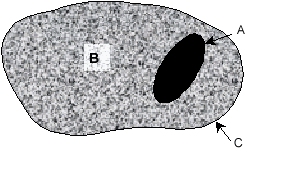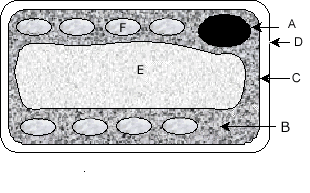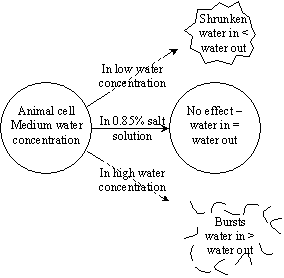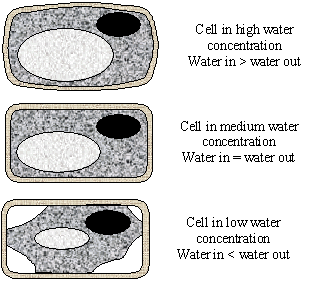|
Cell – Structure and
Function
Examination, with microscopes, of sections of animal and
plant tissues, leads pupils to an awareness of the cellular structure of
living organisms.
Cells are the basic units of life To observe cells under
the microscope we often stain them to make the structures more
visible. Some common stains are:
- Methylene blue – a good general purpose stain
- Iodine – Stains starch grains.
Some organisms are good for observing cells:
- Elodea – Canadian pondweed is excellent for plant cells
- Cheek scrape cells – excellent for observing animal
cells.
The parts of a cell are:
The Animal Cell
 |
A – The nucleus controls the cell’s activities
B – The cytoplasm the chemical reactions of life occur
here
C – The cell membrane controls the entry and exit of
material from the cell.
- The cell membrane is selectively permeable – that
is it allows some substances to pass through and not
others
|
The Plant Cell
The plant cell also has A – nucleus, B Cytoplasm and C –
cell membrane.
 |
It also has:
D – The cell wall rigid structure made of cellulose
give shape to the cell
E – The vacuole liquid filled centre of the cell, gives the
cell rigidity
F – Chloroplasts filled with the green pigment
chlorophyll – photosynthesis occurs
here. |
- A plant cell always has a cell wall
- Animal cells never have cell walls, large vacuoles
or chloroplasts.
 Powerpoint Revision Powerpoint Revision  Test Test  Crossword Crossword
Investigating Diffusion
The aim of this sub-topic is to promote a knowledge and
understanding of the process of diffusion and osmosis.
Diffusion is the movement of solute particles from a
region of higher solute concentration to a region of lower
solute concentration until the solute is evenly spread throughout
the solvent.
- Solute molecules are molecules of a substance dissolved
in a solvent (liquid).
- Solute molecules in a liquid are constantly moving
- That means that any dissolved molecules will be spread
slowly through the liquid
- This process is known as diffusion.
Diffusion is the way many molecules:
- move across membranes:
- between the air and the blood through the lungs.
- Oxygen moves into the blood, carbon dioxide moves out.
- from the inside of the gut into the blood:
- sugar and amino acids diffuse out of the gut into the
blood.
- between the blood and the cytoplasm of cells
through the cell membrane:
- Oxygen and food diffuse from the blood into the
cytoplasm and carbon dioxide and waste diffuse out of the cell into
the blood.
- move within cells.
Osmosis is a special case of diffusion
- Osmosis is the diffusion of water
- We describe osmosis in terms of water
concentration
- Pure water has the highest possible water concentration
- As molecules of solute are added the water
concentration goes down.

- Osmosis can only occur across a selectively permeable
membrane (see cell membrane above).
- Water moves from the higher water concentration to the
lower water concentration.
- In animal cells the point where the water concentration
within the cell balances the water concentration outside the cell is at
0.85% salt solution.
You should be able to say what happens in each of the events
shown by arrows on the diagram.
In plant cells the situation is slightly different

- The possession of a tough cellulose cell wall makes it
impossible for the cell to burst.
- In a high water concentration:
- The vacuole expands as a result of osmosis – animal
cells don’t have these large, central vacuoles.
- Water flows into the vacuole and the cell wall
bulges.
- The cell is described as turgid.
- In a low water concentration:
- the vacuole shrinks,
- the cell membrane pulls away from the cell wall,
- the cell is described a plasmolysed.
 Powerpoint Revision Powerpoint Revision  Test Test  Crossword Crossword
Investigating Cell
Division
This sub-topic seeks to develop pupils’ knowledge and
understanding of the process of mitotic cell division, providing an
opportunity for all pupils to demonstrate their skills in obtaining and
presenting information about chromosome behaviour during cell
division.
- Cell division increases the number of cells in an
organism.
- The control of cell division is within the nucleus.
- Within the nucleus there are thread like structures
called chromosomes which:
- Control the cell
- Carry the hereditary information of the cell (see topic
“Inheritance”).
- Therefore it is essential that the two cells produced
during cell division have a complete set of chromosomes:
Mitosis is the process whereby the nucleus of the
cell divides producing two identical copies of the chromosomes. One
cell with 46 chromosomes divides to form two cells – each with 46
chromosomes.
The number of chromosomes in the cell of an organism is
called the chromosome complement (note the spelling)
Each species has it’s own chromosome complement – ours is
46. Errors in mitosis can rely in the incorrect chromosome complement
that results in a damaged organism. An error that occurs occasionally
results in three copies of chromosome 21 instead of the normal two – this
results in Down’s syndrome.
The process of mitosis is described below:
You should be able to:
- Arrange these events in order if they are shuffled up.
- Describe what happens in each case.
 Powerpoint Revision Powerpoint Revision  Test Test  Crossword Crossword
Investigating Enzymes
Pupils should know that cells produce enzymes and that many
cellular processes depend upon the activity of enzymes. This activity can
be affected by changes in factors such as temperature and pH. Pupils
should understand the specific relationship between an enzyme and its
substrate.
A catalyst:
- Is a chemical which speeds up a chemical reaction
Without being changed itself.
- An enzyme is a biological catalyst.
- It is made of protein It shows an optimum (best)
temperature
- The optimum temperature for human enzymes is 37ºC
- It has an optimum pH
- The optimum pH for catalase is 9 and the optimum pH for
pepsin is 2.5
- It is destroyed above a certain temperature
(usually over 55-60 ºC) It is specific.
- Enzymes do just one job Each type of enzyme (and
there are thousands of types) only carries out one type of reaction
e.g. amylase will only change starch into maltose – nothing else.
- The chemical(s) an enzyme acts on is its
substrate(s) The chemical(s) produced by the enzyme is the
product(s)
- Enzymes are required in cells
- to speed up chemical reactions
- to control the cell –
if an enzyme is present the reaction happens; if not it doesn’t
- Some enzyme reactions break down chemicals e.g.
- Catalase acts on its substrate hydrogen
peroxide to make the products oxygen and water.
- Amylase acts on its substrate starch to make the
product maltose.
- Some enzymes synthesise (build up) more complex
molecules from simpler molecules e.g.
- Potato phosphorylase acts on its substrate
glucose-1-phosphate to make the product starch.
 Powerpoint Revision Powerpoint Revision  Test Test  Crossword Crossword
Investigating Aerobic Respiration
Respiration is a cellular process. Pupils should
understand the cell’s need for energy and should have a basic knowledge
and understanding of how energy is released from food in the presence of
oxygen.
- All living cells need energy for:
- Movement – e.g. muscle cells, white blood cells
Growth Mitosis and cell division To make chemical reactions
happen To move materials across the membrane.
- Food is the source of the energy.
- One gram of fat contains more than twice the energy of
carbohydrates or proteins. This is the reason our bodies use fat as
a storage chemical for energy.
- Oxygen is needed for aerobic respiration.
Aerobic respiration is:
- A chemical process Occurring in all living cells
Which releases energy from food Oxygen is needed for respiration
Carbon dioxide and water are produced as by products. The
molecules of carbon dioxide were once part of the food before it was
broken down by aerobic respiration.
Food + oxygen  energy + CO2 + H2O energy + CO2 + H2O
Food and oxygen produce energy and Carbon dioxide and water
- Respiration is not 100% efficient:
- Not all the energy available from the food is changed
into useful energy for the cell. Some energy is lost as heat. This
heat is used to keep our bodies warm.
The word metabolism represents the sum total of
chemical reactions occurring in the cell.
- The speed at which these reactions occur is called the
metabolic rate.
- Most of the cell’s chemical reactions require energy
- Consequently, without food the cells of the body
eventually run out of energy and stop working.
 Powerpoint Revision Powerpoint Revision  Test Test  Crossword Crossword
|